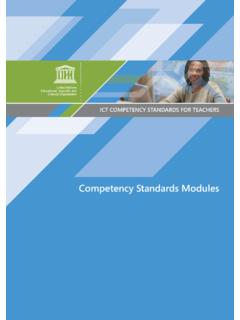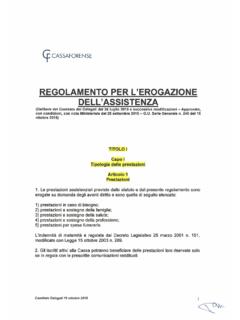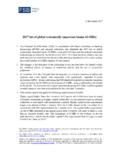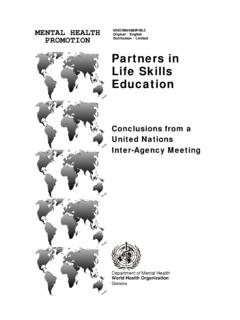Transcription of Open Government: beyond static measures - …
1 open government : beyond static measures A paper produced by Involve for the OECD Karin Gavelin, Simon Burall and Richard Wilson July 2009 2 Executive summary The open government agenda has gained momentum over the past decade. It is now widely acknowledged that greater openness benefits not only citizens but also government itself, by prompting better record management, making decisions and services more efficient and, at best, serving as a safeguard against misgovernment and corruption. The purpose of this paper is to introduce new indicators for measuring government openness. Existing open government indicators tend to focus either on the presence of key laws and institutions, or on citizens perceptions of government performance. Neither option provides a full picture of comparative openness: the former gives little insight into the scope of the laws and institutions measured and the latter does not provide a quantitative picture of actual activities.
2 The indicators proposed in this paper are intended to fill this gap. They seek to complement, rather than replace, the existing data sets used for measuring government openness today. It is hoped that by improving the ways in which we assess open government , this project will contribute to a better understanding of what open government means in practice, which in turn will lead to improvements in the delivery of the openness agenda both in OECD member countries and worldwide. The proposed indicators will be reviewed by the OECD for possible inclusion in future editions of its government at a Glance publication, a biennial report providing a snapshot picture of the performance of OECD member governments on a number of policy areas, including government openness. The suggested indicators are the product of extensive discussions and correspondence between Involve, the OECD and the peer reviewers who contributed to the drafting of this paper.
3 The drafting process took place from March to June 2009. These discussions resulted in a longlist from which the authors of this paper are recommending a shortlist of ten, each with a series of sub-indicators and follow-up questions to provide additional contextual information. They are: Indicators relating to law on access to information and documents: o The law presumes proactive publication of information. o The implementation of the law meets citizens demand for information. o The law ensures equal access to information and documents for all citizens. o Complaints/appeals mechanisms available meet the needs of citizens. Indicators relating to Ombudsman/Information Commissioner Institutions: o The Ombudsman/Information Commissioner is independent of the Executive. o The Ombudsman/Information Commissioner s findings are acted upon. o The Ombudsman/Information Commissioner provides equal access to its reports and services for all citizens.
4 Indicators relating to Supreme Audit Institutions: o The Supreme Audit Institution is independent of the Executive. o The Supreme Audit Institution s findings are acted upon. Indicators relating to consultation policies: o Public bodies are required to consult with citizens or other stakeholders in decision making. These headline indicators should be read in conjunction with their respective sub-indicators and follow-up questions, as set out in Table 1. 3 Table 1: Shortlisted indicators on open government Indicators relating to law on access to information and documents Suggested indicators Sub-indicators Follow-on question for contextualisation The law presumes proactive publication of information. Are officials obliged to proactively publish information and documents? If yes: within what timeframes? If yes: which of the following categories of information are published proactively?
5 : structural information on the structure, functions and activities of the organisations, including annual reports budget documents tenders and contracts access to information procedural information information describing the types of record systems and their contents and uses information on internal law and how policies/decisions are made all government reports commonly requested documents. The implementation of the law meets citizens demand for information. How often are exemptions used (% of total number of requests for information)? What are the five most commonly employed exemptions? How often are requests for information refused (% of total number of requests for information)? n/a The law ensures equal access to information and documents for all citizens. Is there a fee for making requests? If yes: what is the cost of making a request for information (% of average monthly income)?
6 If yes: are exceptions available for those on low income? If yes: are exceptions available for requests made in the public interest? In how many of the following ways can requests be made? in person by phone/fax online by email by mail. n/a Complaints/appeals mechanisms available meet the needs of citizens. How many appeals are made (% of total number of requests)? What percentage of appeals are upheld? Are public interest tests used to override exemptions/refusals? n/a 2. Indicators relating to Ombudsman/ Information Commissioner Institutions Suggested indicators Sub-indicators Follow-on question for contextualisation The Ombudsman/Information Commissioner is independent of the Executive. Does the Ombudsman/Information Commissioner submit its own budget requests to the legislature? n/a Is the Ombudsman appointed and removed by an individual/body independent of the Executive?
7 Who appoints/removes the Ombudsman? 4 The Ombudsman/Information Commissioner s findings are acted upon. Does the Ombudsman/Information Commissioner have the power to issue binding orders? n/a What % of recommendations/orders made by the Ombudsman/Information Commissioner are implemented? n/a The Ombudsman/Information Commissioner provides equal access to its reports and services for all citizens. Is there a fee for making appeals or complaints to the Ombudsman/Information Commissioner? If yes: how much are the fees (% of average monthly income)? Is the Ombudsman/Information Commissioner obliged to make its findings and recommendations publicly available? n/a Are actions taken or responses made by public bodies as a result of the Ombudsman/Information Commissioner s recommendations made public? n/a 3. Indicators relating to Supreme Audit Institutions Suggested indicators Sub-indicators Follow-on question for contextualisation The Supreme Audit Institution is independent of the Executive.
8 Does the Supreme Audit Institution submit its own budget requests to the legislature? n/a Is the Head of the Supreme Audit Institution appointed by an individual/body independent of the Executive? Who appoints/removes the Head of the Supreme Audit Institution? Does the Supreme Audit Institution have the legal right to undertake audits of its choice? n/a The Supreme Audit Institution s findings are acted upon. Does the Supreme Audit Institution have the power to issue binding orders? n/a What % of recommendations/orders issued by the Supreme Audit Institution are implemented? n/a 4. Indicators relating to consultation policies Suggested indicator Sub-indicators Follow-on question for contextualisation Public bodies are required to consult with citizens or other stakeholders in decision making. Does the scope of the policy cover all organisations and institutions delivering services to the public?
9 If no: what organisations and institutions are exempt from the law? Are public bodies required to publish an official response at the end of a consultation exercise? n/a 5 Contents About Involve 6 Acknowledgements 7 1 Introduction 8 2 Scope and limitations 10 3 open government what it means and why it matters 12 4 Comparing openness building a fuller picture 15 4 Suggested indicators 22 Bibliography 29 Appendix 1: Other international studies of open government 32 Appendix 2: Appendix 3: Approach 35 6 About Involve Involve specialises in public participation; it brings institutions, communities and citizens together to accelerate innovation, understanding, discussion and change. Involve makes a practical difference by delivering high quality public participation processes as well as undertaking research and policy analysis into what works in public and stakeholder involvement.
10 It is a not for profit organisation, which receives funding from the Joseph Rowntree Charitable Trust, the Big Lottery Fund and the Esm e Fairbairn Foundation, among others. Involve has helped leading public bodies and companies including the OECD, the Ministry of Justice, the Department for Communities and Local government , the European Commission, the States of Jersey, the Sustainable Development Commission, the BBC, the NHS Centre for Involvement, the Cabinet Office and numerous local authorities engage with the public. For more information visit Involve s website or contact 7 Acknowledgements The authors would like to acknowledge the invaluable feedback, questions and comments from the following individuals who read and commented on drafts of this paper. Inclusion in this list does not imply formal approval by these individuals and institutions of the content of this paper.
















